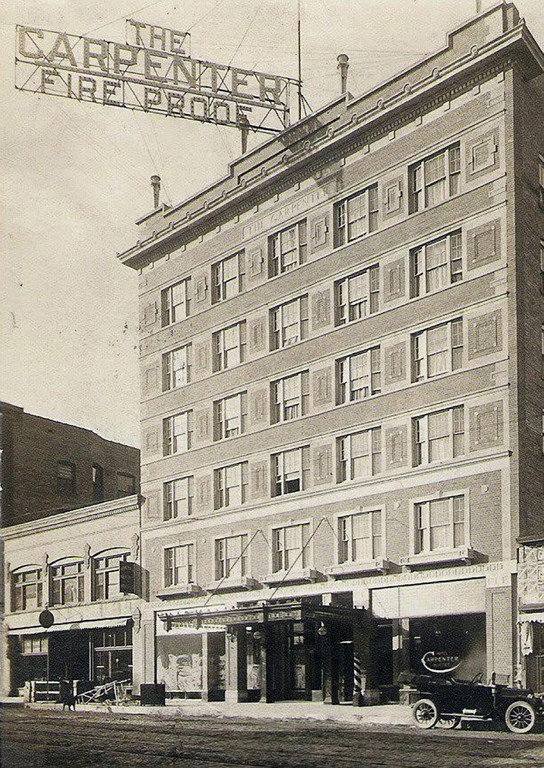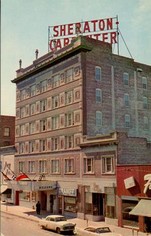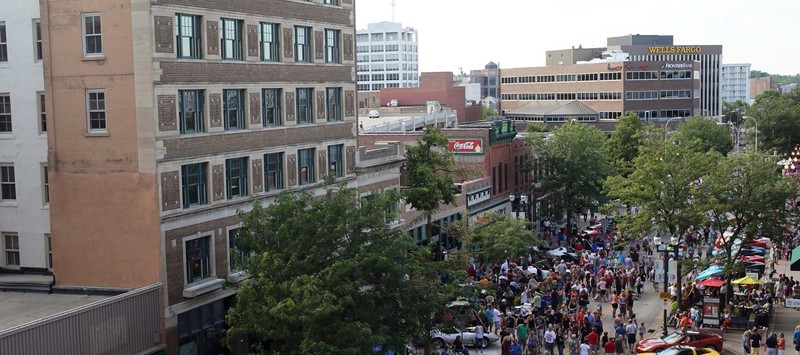Carpenter Hotel (Carpenter Building)
Introduction
Text-to-speech Audio
Built in 1912 by Frances G. Carpenter, the widow of Sioux Falls land developer and stockyards investor, C.C. Carpenter, the building has provided first class accommodations to guests that ranged from farmers and their wives to celebrities and Royal dignitaries. The hotel later housed soldiers during WWII, operated as a college dormitory and was home to KSOO radio station. From its inception, as it does today, it boasts of its luxury, and of its fireproof nature.
Images
Early twentieth-century picture of the hotel, via "The Carpenter" website.

Carpenter, when owned by Sheraton

Street Fest, modern Sioux Falls.

Backstory and Context
Text-to-speech Audio
The Carpenter Hotel opened its doors in 1912 and arguably served as Sioux Falls' most popular hotel for decades -- guests ranged from celebrities and dignitaries to farmers and soldiers. Frances Carpenter built the hotel after her husband, Charles, had passed away. As an Eastern U.S. banker who moved to Sioux Falls, Charles invested heavily in the Sioux Falls land and the Stock Yards; he was integral in the development of Sioux Falls.
The hotel's arrival coincided with a steady increase in Sioux Falls population, much it due to the opening of the John Morrell Meatpacking plant in 1909. From 1900 to 1920, Sioux Falls population rose from a little more than 10,000 to roughly 25,200, much of that from 1910 to 1920 when Sioux Falls boasted of a more than 75% population increase.
The hotel's arrival coincided with a steady increase in Sioux Falls population, much it due to the opening of the John Morrell Meatpacking plant in 1909. From 1900 to 1920, Sioux Falls population rose from a little more than 10,000 to roughly 25,200, much of that from 1910 to 1920 when Sioux Falls boasted of a more than 75% population increase.
The hotel was South Dakota's first masonry hotel. As was the case with many cities, fire often destroyed many early downtown, wooden-framed structures. Thus, the move to masonry allowed hotels like the Carpenter to boast of being "fireproof," made clear by the large, metal sign that adorned the rooftop and jetted outward, proclaiming that it was indeed impervious to fire.
While the outside contained brick and decor, the first class accommodations inside the building provided to be its biggest draw. When the hotel opened, it boasted 150 rooms (80 with private bath) and a high-class café. The first-floor dining room and ballroom also served as the place for balls, proms, weddings and other social functions. Famous guests at the hotel included Bob Hope; Prince Olaf and the Queen of Norway; Alfred and Lynn Fontanne; Benny Goodman, Jimmy and Tommy Dorsey and Bob Chesterfield.
But, it should be noted that the hotel served a variety of clientele. For instance, wives of farmers with interests at the Sioux Falls often stayed at the hotel and spent their days dining, shopping or at a movie theater in downtown Sioux Falls. The resultant influx of women paved the way for the opening of Gordon's Beauty salon on the second floor. Other prominent Sioux Falls residents maintained permanent residences on the hotels' 5th and 6th floors. And, in 1926, a portion of the sixth floor also served as the studio home of KSOO radio.
The 1942 construction of the Sioux Falls air base doubled the size of the town from 40,000 to nearly 80,000. And, it profoundly changed how the Carpenter operated. During WWII, five railroads brought in troop trains who stayed in the hotel for six weeks as they trained for various military duties (mostly radio training). During the war, though, the basement billiard hall was converted into a dormitory. Individual cubicles were built and cost $0.50 a night.
In 1956, the Sheraton Corporation purchased and renovated the hotel and renamed it "The Sherwyn." By the 1970′s the hotel rooms were converted into dormitory rooms for the Nettleton College, a business school. The name changed to Nettelton Manor, but that only lasted until 1983.
Plans in 1992 to tear down the vacant Carpenter Building never materialized due to the high cost attached to its demolition. Two years later, local businessman David Dyke purchased the building and sought to restore it to its original first-class glory. Eventually helped by the city of Sioux Falls, the Carpenter received a facelift that included interior restoration and more than 80 new windows a restored facade. In March of 2015, the Scherschligt Family purchased the Carpenter with the goal to continue the work started by Dyke.
Finally, today, it's owners note: "The Carpenter Building’s impressive structure boasts 21 luxury apartments, a floor of professional businesses and six street-level retail businesses." And, one of its amenities includes the line, "Fireproof, Solid and Quiet Structure," just as it was in 1912.
Sources
Carlsen, Chris J. "Nomination Form: Carpenter Hotel (Carpenter Building)." National Register of Historic Places. June, 11, 1986. https://npgallery.nps.gov/GetAsset/db064853-cdbd-4c81-a3fd-05d3c8baca82
"History of the Carpenter Building." The Carpenter. Accessed January 17, 2018. http://www.thecarpenterbuilding.com/history/.
Staggers, Kermit L. "Sioux Falls, South Dakota." Encyclopedia of the Great Plains. Accessed January 18, 2018. http://plainshumanities.unl.edu/encyclopedia/doc/egp.ct.048
"History of the Carpenter Building." The Carpenter. Accessed January 17, 2018. http://www.thecarpenterbuilding.com/history/.
Staggers, Kermit L. "Sioux Falls, South Dakota." Encyclopedia of the Great Plains. Accessed January 18, 2018. http://plainshumanities.unl.edu/encyclopedia/doc/egp.ct.048
Picture Sources
Carpenter, when owned by Sheraton: https://i.pinimg.com/236x/46/96/bb/4696bb70ad00ac508b30e88f0a464700--wedding-greetings-the-carpenter...
Early twentieth-century picture: http://www.thecarpenterbuilding.com/wp-content/uploads/2016/01/CARPENTER-RESIZED-768x1085.jpg, via The Carpenter Building website
Street Fest, Modern Sioux Falls: Photo found at http://www.thecarpenterbuilding.com
----
Note: PDF archive of photos located at the National Register of Historic Places at https://npgallery.nps.gov/GetAsset/6df9fbb7-5d3c-4af8-b7d0-728bb230c145
Other photos can be found on Flickr.com: https://www.flickr.com/photos/dickjohnson/37662030761 (Photos taken by Richard Johnson, all rights reserved)